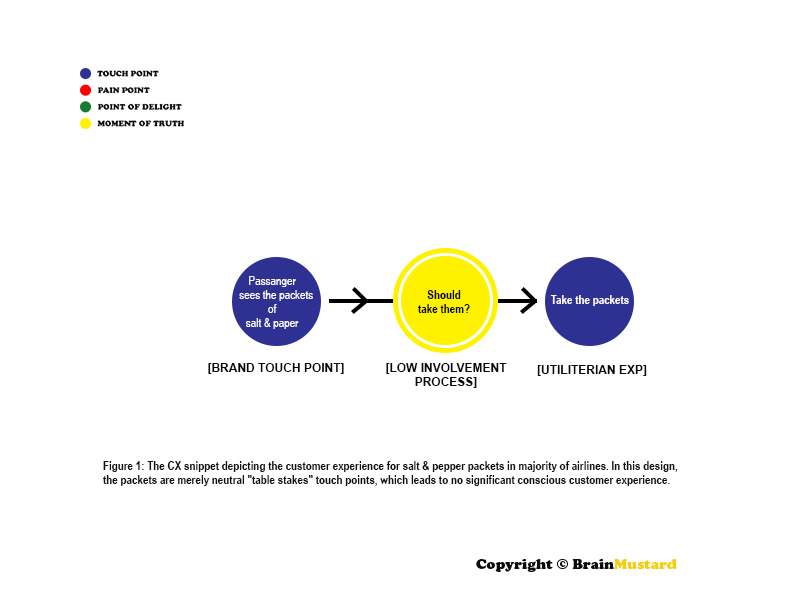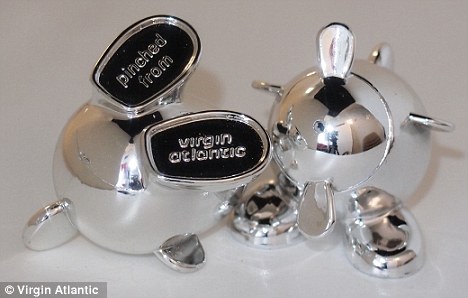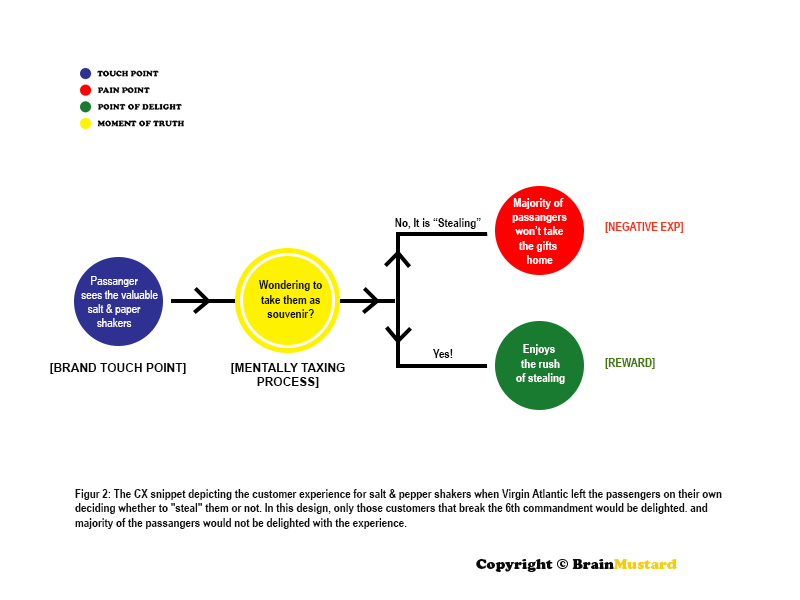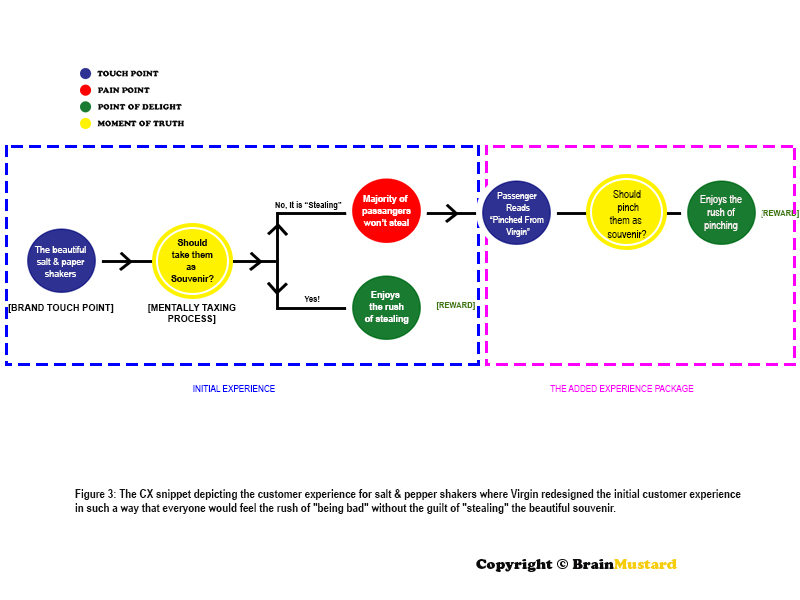How Virgin Atlantics Uses Guilty Pleasure to Make Customer Experience Memorable
BrainMustard Customer Experience Design Series
About this Article
The Customer Experience Series by BrainMustard are based on the customer experience maps and social influence graphs built from scanning and analyzing millions of contents from the Internet chatter.
These models and maps offer revealing and unexpected consumer insights to formulate new initiatives to increase sales. Check out our success stories at http://www.BrainMustard.com
Tweet
Virgin Atlantic’s Guilty Pleasure Sentiment with Salt and Pepper Shakers
A few years ago, my wife and I were excited about flying Emirates’ A380 first class to Dubai. Among other things, we were handed a gorgeous and luxurious kit of amenities. I would have attached a picture of it only if I knew its whereabouts. In fact, the kit was long forgotten and was never talked about ever since. It certainly was a delighter at the time but the positive experience of it was not impactful enough to render the experience sticky and memorable. Businesses can’t expect much from free giveaways in terms of enhancing customer experience. Or can they?

Figure 1: The CX snippet depicting the customer experience for salt & pepper packets in majority of airlines. In this design, the packets are merely neutral "table stakes" touch points, which leads to no significant conscious customer experience.
***
It’s the very end of the winter season, and you’re itching to take that time off work that you weren’t granted at Christmas or peak season because too many of your coworkers beat you to the punch of inquiring with your boss about spending time with family in another country and the convenience of the holiday season. And they already booked their flights, so you don’t really have that option either.
What you do have, though, is a last minute getaway courtesy of Virgin Atlantic, and you’re fast-tracking to your much-needed holiday months after you’d hoped for it.
And Virgin Atlantic knows that you’re in vacation mode as soon as you hit the airport. The only thing you care about is making it safely from Point A to Point B. You’ve spent some cold hard cash, and you’re ready to make the most of your in-flight experience.
***

Image: The gorgeous salt and pepper shaker at Virgin Atlantic
So when the tempting little airplane-shaped salt and pepper shakers arrive at your seat at meal time, you can’t help but pick them up, shake them a bit, and wonder whether the guy in Seat 12B is thinking the same thing as you. Chances are, he probably is. You put the shakers down, expecting that a flight attendant is going to walk by and reprimand you for toying with the unassuming salt-and-pepper pair. She doesn’t.

Figure 2 : The salt & pepper shaker experience when Virgin Atlantic left the passengers to decide whether to "steal" them or not. In this design, only those few customers that broke the 8th commandment and stole the shakers were delighted, and the remaining majority only felt the pain of a mentally taxing process of self-negotiation.
After your flight has landed, you survey fellow passengers for a sense of whether they have had the same thought as you—have they, too, coyly stuffed the salt and pepper shakers into the carry-on luggage, sneakily departing the aircraft with an air of pride?
You have activated your guilty pleasure senses, and have stolen something without truly stealing.
***
What exactly was it that triggered you to want to take this complimentary item home with you? Was it the eye-catching design by the airline? The miniature size that reminded you to carry salt and pepper on you whenever you dine out, just in case the meal hasn’t got the right kick of flavor? Or has Virgin Atlantic evoked a sense of mischief and temptation by tricking you to give in to the Eighth Commandment?
Virgin Atlantic’s tactic here was offering a small delighter, in the form of the salt and pepper set, to enhance the customer’s experience aboard one of their company’s flights. Their success comes from offering the customer a novelty of choice: do they debark the flight empty-handed, or do they give in to their temptation and take the salt and pepper set that’s been on their mind since their complimentary dinner along for the rest of their journey?
Since walking away with the set has not been deemed a no-can-do, this ultimately lowers guilt for the customer as it becomes more “pinching” rather than actual stealing. Even so, this act of “pinching” gives the customer enough of an adrenaline rush to produce the incredible sensory experience of the body fulfilling an act of guilty pleasure.

Figure 3: The CX snippet depicting the customer experience for salt & pepper shakers where Virgin redesigned the initial customer experience in such a way that everyone would feel the rush of "being bad" without the guilt of "stealing" the beautiful souvenir.
Since this act gets the customer completely involved at both sensory and cognitive levels, the experience has been rendered memorable, and the positive sentiment notion created by Virgin Atlantic has allowed them to capitalize on this product.
As the novelty wore off and became pervasive, the set is no longer available on Virgin Atlantic flights. Those who gave in to their guilty pleasures now have valuable, conversation-starter items that everyone is continuously trying to get their own hands on.
***
The good news is that the success of Virgin Atlantic with their “free giveaways” is not a one off success story. In fact, if anything, the result was a sure-fire and predictable given proper execution. Marketing and creative teams using a thorough customer experience map are able to imagineer (imagine + engineer) complex experiences where the consumers engage in interactions with touch points (here salt pepper shakers) at sensory, emotional, and cognitive levels and are posed with moments of truth that force the consumers to undergo mentally taxing and difficult decision making processes. This level of engagement, inherently, is memorable and worthy to be talked about.
***
Tweet
Looking for similar articles from BrainMustard? Click Here
Copyright © BrainMustard
A few years ago, my wife and I were excited about flying Emirates’ A380 first class to Dubai. Among other things, we were handed a gorgeous and luxurious kit of amenities. I would have attached a picture of it only if I knew its whereabouts. In fact, the kit was long forgotten and was never talked about ever since. It certainly was a delighter at the time but the positive experience of it was not impactful enough to render the experience sticky and memorable. Businesses can’t expect much from free giveaways in terms of enhancing customer experience. Or can they?

Figure 1: The CX snippet depicting the customer experience for salt & pepper packets in majority of airlines. In this design, the packets are merely neutral "table stakes" touch points, which leads to no significant conscious customer experience.
It’s the very end of the winter season, and you’re itching to take that time off work that you weren’t granted at Christmas or peak season because too many of your coworkers beat you to the punch of inquiring with your boss about spending time with family in another country and the convenience of the holiday season. And they already booked their flights, so you don’t really have that option either.
What you do have, though, is a last minute getaway courtesy of Virgin Atlantic, and you’re fast-tracking to your much-needed holiday months after you’d hoped for it.
And Virgin Atlantic knows that you’re in vacation mode as soon as you hit the airport. The only thing you care about is making it safely from Point A to Point B. You’ve spent some cold hard cash, and you’re ready to make the most of your in-flight experience.

Image: The gorgeous salt and pepper shaker at Virgin Atlantic
So when the tempting little airplane-shaped salt and pepper shakers arrive at your seat at meal time, you can’t help but pick them up, shake them a bit, and wonder whether the guy in Seat 12B is thinking the same thing as you. Chances are, he probably is. You put the shakers down, expecting that a flight attendant is going to walk by and reprimand you for toying with the unassuming salt-and-pepper pair. She doesn’t.

Figure 2 : The salt & pepper shaker experience when Virgin Atlantic left the passengers to decide whether to "steal" them or not. In this design, only those few customers that broke the 8th commandment and stole the shakers were delighted, and the remaining majority only felt the pain of a mentally taxing process of self-negotiation.
You have activated your guilty pleasure senses, and have stolen something without truly stealing.
What exactly was it that triggered you to want to take this complimentary item home with you? Was it the eye-catching design by the airline? The miniature size that reminded you to carry salt and pepper on you whenever you dine out, just in case the meal hasn’t got the right kick of flavor? Or has Virgin Atlantic evoked a sense of mischief and temptation by tricking you to give in to the Eighth Commandment?
Virgin Atlantic’s tactic here was offering a small delighter, in the form of the salt and pepper set, to enhance the customer’s experience aboard one of their company’s flights. Their success comes from offering the customer a novelty of choice: do they debark the flight empty-handed, or do they give in to their temptation and take the salt and pepper set that’s been on their mind since their complimentary dinner along for the rest of their journey?
Since walking away with the set has not been deemed a no-can-do, this ultimately lowers guilt for the customer as it becomes more “pinching” rather than actual stealing. Even so, this act of “pinching” gives the customer enough of an adrenaline rush to produce the incredible sensory experience of the body fulfilling an act of guilty pleasure.

Figure 3: The CX snippet depicting the customer experience for salt & pepper shakers where Virgin redesigned the initial customer experience in such a way that everyone would feel the rush of "being bad" without the guilt of "stealing" the beautiful souvenir.
Since this act gets the customer completely involved at both sensory and cognitive levels, the experience has been rendered memorable, and the positive sentiment notion created by Virgin Atlantic has allowed them to capitalize on this product.
As the novelty wore off and became pervasive, the set is no longer available on Virgin Atlantic flights. Those who gave in to their guilty pleasures now have valuable, conversation-starter items that everyone is continuously trying to get their own hands on.
The good news is that the success of Virgin Atlantic with their “free giveaways” is not a one off success story. In fact, if anything, the result was a sure-fire and predictable given proper execution. Marketing and creative teams using a thorough customer experience map are able to imagineer (imagine + engineer) complex experiences where the consumers engage in interactions with touch points (here salt pepper shakers) at sensory, emotional, and cognitive levels and are posed with moments of truth that force the consumers to undergo mentally taxing and difficult decision making processes. This level of engagement, inherently, is memorable and worthy to be talked about.
Tweet
Looking for similar articles from BrainMustard? Click Here
Copyright © BrainMustard